
18. General. Marksmanship training for the Starlight Scope must be considered as a continuation of marksmanship training received by the rifleman, grenadier, machinegunner, or recoilless rifle rifleman. Many of the elements of marksmanship as taught for each of these weapons must also be practiced when using the Starlight Scope. If the soldier has mastered these fundamentals, he can expect excellent results when employing the Starlight Scope in its weapons mounted role. Marksmanship training as contained in FM 23-67, FM 23-71, FM 23-11, FM 23-9, FM 23-31, and FM 23-33 provides a firm foundation for Starlight Scope marksmanship training. Army Subject Schedule 23-39 also provides an excellent guide for the conduct of training Starlight Scope operators.
19. Purpose of Marksmanship Training. Marksmanship training is designed to develop skills in aiming and zeroing techniques so that the soldier can effectively employ the Starlight Scope to detect and place aimed fire on an enemy at night.
20. Aiming and Positions. The integrated act of shooting (aiming and steady hold) applies equally when firing the rifle with the Starlight Scope mounted.
21. Aiming. In aiming, the firer is concerned with correctly pointing his weapon so that the bullet or projectile will hit the target when he fires. Normally, with the exception of the recoilless rifle rifleman, this requires proper alinement of the front and rear sights in relation to the target. This relationship is known as sight picture and involves two elements: sight alinement and placement of the aiming point. Since the Starlight Scope is an optical instrument which does not require alinement of a front and rear sight, the operator need only be concerned with the placement of the aiming point to obtain the correct sight picture.
a. The correct sight picture (stationary target) is obtained when the aiming references dot (beadtype reticle) of the sight reticle is positioned in the center of mass of the target (fig. 18).
b. The correct sight picture (stationary target) is obtained when the top of the center line (black line reticle) of the sight reticle is positioned in the center of mass of the target (fig. 19).
22. Positions. Since the Starlight Scope, when installed, increases the weight of the weapon (5 pounds, 14 3/4 ounces), the importance of obtaining a good firing position and applying as many of the steady hold factors as possible cannot be overemphasized. The basic positions as taught in the field manuals listed in paragraph 18 should be used. However, it will be necessary to modify the position of the head to compensate for the "offset" of the Starlight Scope from the weapon.
a. The Starlight Scope may be employed from any firing position (fig. 20 through 33).
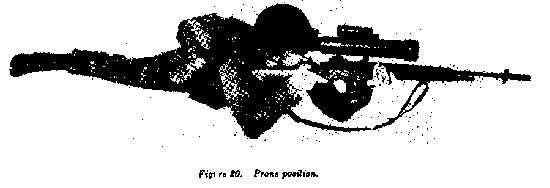

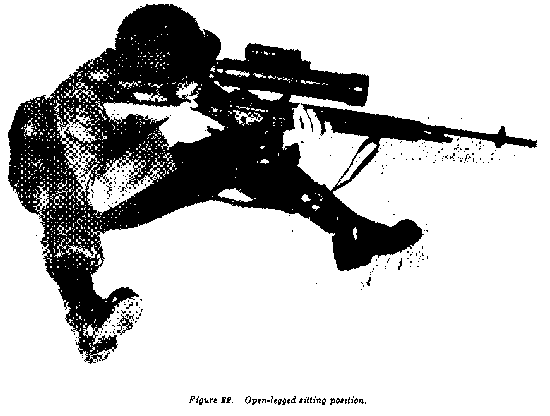
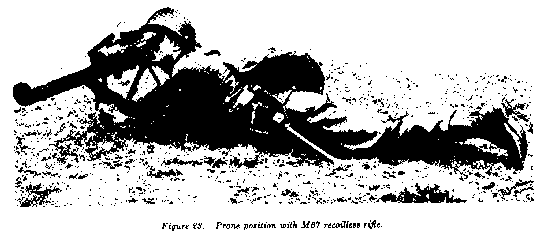


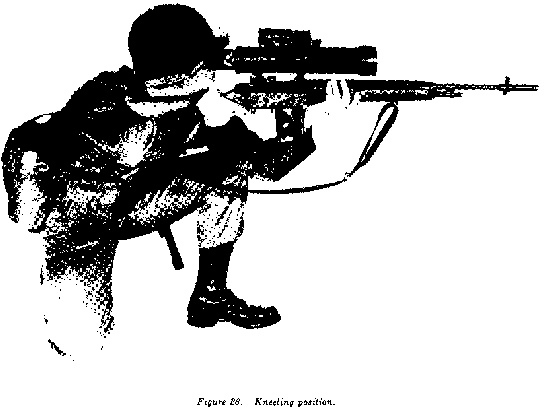





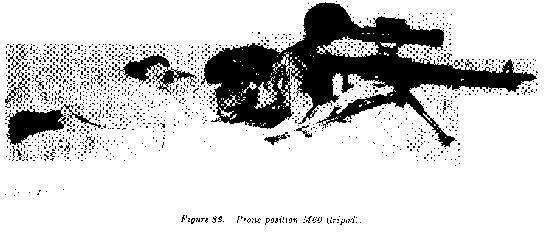

b. The positions beat suited for operation of the Starlight Scope are those that afford the greatest stability. Normally, these positions are the prone supported, foxhole supported, and the biped or tripod mounted positions.
23. General. The Starlight Scope may be zeroed during the hours of daylight or darkness. The lens cap must be positioned over the objective lens during daylight operation. When zeroing in daylight, it may be necessary to cover one or two of the small pinholes in the lens cap to reduce the amount of light entering the Starlight Scope. If it is necessary to cover one or two of the holes in the lens cap for daylight zeroing, then provisions should be made to permit the operator to reconfirm his zero during the hours of darkness without the lens cap. The reason for this is: when one or more holes in the lens cap are covered and the cap is rotated on the objective lens, the accuracy of the zero may change. The operator may also experience difficulty when attempting to zero the Starlight Scope just prior to darkness (dusk). The light level at dusk is too low to permit the image intensifier tube to resolve the zero target with the lens cap in place, yet the light 1evel at dusk is still intense enough to cause the image intensifier tube to automatically cut off when the lens cap is removed from the objective lens.
24. Zeroing the Starlight Scope to the M14, M14A2, or XM16E1 Rifles. The recommended distance for zeroing the Starlight Scope is l50 meters. When the Starlight Scope has been zeroed at 150 meters, the bottom dot of the sight reticle is positioned in the center of mass of the target to obtain the correct sight picture for engagement of target at 300 meters. However, an accurate zero may also be obtained at either a closer or greater range. There are several methods of zeroing the Starlight Scope. They are:
a. Stable Rest Zeroing. This method of zeroing the Starlight Scope requires a minimum of ammunition; however, the accuracy of the zero is dependent on the stability of the rest. Zeroing is accomplished as follows:
(1) Place or select a target at the desired zero range. The battlesight zero range of 250 meters may be used or a greater or lesser range may be more practical. Regardless of what zero range is used, the firer must know the rear sight setting of his weapon for that particular range.
(2) Adjust the rear sight of the weapon for the zero range.
(3) Mount the Starlight Scope to the weapon and place the combination onto a stable rest.
(4) Carry out operating instructions as outlined in paragraph 9e (l) through (4).
(5) Sight through the rear sight of the weapon (not Starlight Scope) and aline on the aiming point of the zero target.
(6) Without disturbing the lay of the weapon or Starlight Scope combination, sight through the Starlight Scope and, by manipulating the azimuth and elevation adjustment knobs, move the sight reticle until the aiming reference dot is alined on the same point of aim as the sights of the rifle.
(7) When the aiming reference dot and the rifle sights are alined on the same point of aim on the zero target, the Starlight Scope and weapon are zeroed for that specific range. Situation permitting, the operator should fire a few rounds to confirm the zero. When making adjustments in elevation or deflection, adjustments are made in the direction of the error.
b. Battlesight Zeroing. In keeping with current doctrine of the United States Army, which prescribes a 250-meter battlesight zero and the soldier’s need to be able to determine this zero at 26 meters or 1,000 inches, a battlesight zero for the Starlight Scope may also be obtained at this range. The principles of zeroing, as described in FM 23-71, form a firm basis for teaching battlesight zeroing of the Starlight Scope. The 25-meter zero target may be used; however, the center of the shot group has been moved to compensate for the offset of the Starlight Scope when mounted. The Starlight Scope is zeroed at 25 meters as follows:
(1) Mount the Starlight Scope to the M14, M14A2, or XM16E1 rifle.
(2) The operator may select what position is to be used; however, the foxhole, prone supported, or biped position is recommended for greater stability. The position selected must be located at the prescribed 25 meters or 1,000 inches from the target.
(3) Carry out operating instructions as described in paragraph 9e (1) through (4).
(4) Sight through the Starlight Scope and position the aiming reference dot of the sight reticle on the target as illustrated in  and
and  , figure 34. Fire a three-round shot group, insuring that the aiming reference dot is at the exact same point of aim on the target each time a round is fired.
, figure 34. Fire a three-round shot group, insuring that the aiming reference dot is at the exact same point of aim on the target each time a round is fired.
(5) Move to the target line and analyze the target to determine the location of the center of the shot group in relation to point of aim. The correct relationship between point of aim and the center of the shot group when zeroing with the M14 or M14A2 rifles is illustrated in  , figure 34. The correct relationship when firing the XM16E1 rifle is illustrated in
, figure 34. The correct relationship when firing the XM16E1 rifle is illustrated in  , figure 34.
, figure 34.
(6) Adjust the sight reticle by turning the elevation and/or azimuth adjustment knobs until the aiming reference dot is at the prescribed location as illustrated in  and
and  , figure 34. One click of the azimuth or elevation adjustment knob will move the strike of the bullet 1.27 centimeters or a little less than one square on the 25-meter target. Adjustments are made in the direction of the error from where the center of the shot group must be. For example, if the center of the shot group is high and left of where the shot group must be, then the operator adjusts for this error by moving the sight reticle up and to the left.
, figure 34. One click of the azimuth or elevation adjustment knob will move the strike of the bullet 1.27 centimeters or a little less than one square on the 25-meter target. Adjustments are made in the direction of the error from where the center of the shot group must be. For example, if the center of the shot group is high and left of where the shot group must be, then the operator adjusts for this error by moving the sight reticle up and to the left.
(7) Repeat the procedures as outlined in (4) through (6) above until proper relationship between the point of aim and the center of the shot groups has been obtained.
(8) A method of obtaining a battlesight zero at 4 meters can also be accomplished by following the procedures outlined in (4) through (7) above, and by changing the relationship of the point of aim and the strike of the round as illustrated in  , figure 34, for the M14 and M14A2
, figure 34, for the M14 and M14A2  , figure 34, for the XM16E1 rifle. When obtaining a 4-meter zero the (operator must try for as accurate a zero as possible, for a very slight error at 4 meters results in a major error at 250 meters.
, figure 34, for the XM16E1 rifle. When obtaining a 4-meter zero the (operator must try for as accurate a zero as possible, for a very slight error at 4 meters results in a major error at 250 meters.
(9) The advantage of the 4-meter zero, as compared to a 25-meter zero, is that the operator can see the strike of the round on the target and can adjust the sight reticle without moving from the weapon, thus eliminating movement time between weapon and target and reducing the time required for zeroing. When zeroing at 4 meters, each click of the azimuth or elevation adjustment knob moves the strike of the round .2 centimeter.
(10) Due to the differences between firers, weapons, and ammunition, and the difficulty in obtaining a precise zero at 4 or 25 meters, zeroes obtained at these ranges should be confirmed by firing on the actual range.
c. Field Expedient Zeroing. This method of zeroing is similar to the method described in FM 23-71. This method may require the use of an observer to assist in locating the strike of the round and giving the changes in elevation and deflection necessary to bring it to the point of aim. During daylight zeroing the observer should be equipped with binoculars, and during the hours of darkness a Starlight Scope, to assist him in this procedure. This method of zeroing is conducted as follows:
(1) The operator mounts the Starlight Scope to his weapon and carries out operating instructions as described in paragraph 9e (1) through (4).
(2) The operator and observer pick out a target that provides a definite point of aim and one that will aid in observing the strike of the bullet. This can be a hillside, a brick house, or any dry or metal surface.
(3) Center the aiming reference dot in the Starlight Scope’s field of view. This may be accomplished by sighting through the scope and estimating if the aiming reference dot is centered. It may also be accomplished by counting the total number of clicks the aiming reference dot can be moved in both elevation and azimuth and then positioning the aiming reference dot at midpoint.
(4) Place the aiming reference dot at the point of aim and fire one round. The observer notes the strike of the bullet and gives the elevation and deflection change necessary to bring it to the point of aim. He does this by estimating the distance between the strike of the bullet and the aiming point. He converts these distances to clicks by dividing the error (in inches) by the number of inches one click will move the strike of the bullet at that range. For example, an operator fires one round at his zero target at a range of 150 meters. The observer estimates the strike of the round to be 2 feet above and 3 feet right of the aiming point. His corrections would be: up 8 clicks (24 inches at that range) and right 12 clicks (36 inches at that range). The operator makes these adjustments to the reticle and fires a confirming round.
(5) He continues the foregoing procedures until the point of aim and strike of the bullet coincide.
(6) Because the operator is making a sight change on the basis of one shot, it is extremely important that the shot be well-aimed and correctly fired. He should also use his most stable firing position.
d. Holdoff. To engage targets at other than the zero range, the operator must apply holdoff to compensate for the rise and fall in the trajectory of the round. To engage targets at ranges less than the zero range, the point of aim will be below the center of mass.
25. Zeroing Starlight Scope to M60 Machinegun. The procedures used to zero the Starlight Scope to the M60 machinegun are basically the same as those for the rifle. Zeroing can be accomplished using the basic (l0-meter) method, known distance target method, and the field expedient method. Regardless of which procedure is used, the basic marksmanship techniques as described in FM 23-67 will apply.
a. Basic (10-Meter) Zero. This method of zeroing is equivalent to a 300-meter zero and target may be used when engaging targets at ranges of 500 meters or less. The standard 25-meter fig. 34), modified as shown, is used in lieu of the standard machinegun targets; however, the target is still positioned 10 meters from the muzzle of the weapon. Zeroing is accomplished as follows:
(1) Mount the Starlight Scope to the M60 machinegun and carry out operating instructions as described in paragraph 9e (1) through (4).
(2) Sight through the Starlight Scope and position the aiming reference dot of the sight reticle on the target as illustrated  , figure 34. Fire three rounds (single shot) to establish a shot group. The operator must insure the aiming reference dot is positioned at the exact same point of aim each time a round is fired.
, figure 34. Fire three rounds (single shot) to establish a shot group. The operator must insure the aiming reference dot is positioned at the exact same point of aim each time a round is fired.
(3) The operator checks his target to determine the location of the center of the shot group in relation to where his rounds must strike the target for an accurate zero. The correct relationship between the point of aim and the center of the shot group is illustrated in  , figure 34. This relationship must be obtained to have an accurate 10-meter zero. If the center of the shot group is other than shown in
, figure 34. This relationship must be obtained to have an accurate 10-meter zero. If the center of the shot group is other than shown in  , figure 34, then the operator must adjust the elevation and/or azimuth adjustment knob of the Starlight Scope to bring the point of aim and the center of the shot group into proper alinement.
, figure 34, then the operator must adjust the elevation and/or azimuth adjustment knob of the Starlight Scope to bring the point of aim and the center of the shot group into proper alinement.
(4) After making adjustments for elevation and/or deflection, the operator relays on his target and fires a confirming round. If the round does not strike the target at the desired location, he treats this hit as the center of a three-round shot group, makes further adjustments as necessary, and fires another round. He continues this procedure until the point of aim and the strike of the round are in the proper relationship.
b. Known Distance Target Method. When using this method to zero the M60 machinegun, the tripod should be used. If the tripod is not available, a stable rest must be provided to afford maximum stability for the weapon and Starlight Scope combination. The Starlight Scope is zeroed to the M60 machinegun as follows:
(1) Zero the M60 machinegun.
(2) Mount the Starlight Scope to the M60 machinegun and carry out operating instructions as described in paragraph 9e (1) through (4).
(3) Select a target at a known distance. Place this range setting on the rear sight and aline the sight on the distant aiming point.
(4) Without disturbing the lay of the weapon, sight through the Starlight Scope and aline the aiming reference dot on the same point of aim.
(5) Recheck to insure the lay of the weapon has not been disturbed and that both sights are alined on the same point of aim on the target.
(6) If the situation permits, fire a few rounds to confirm the zero.
c. Field Expedient Zeroing. The procedures as prescribed in paragraph 24c may be used to zero the Starlight Scope to the M60 machinegun. The operator may fire a short burst in lieu of the one round as described.
d. 500-Meter Zero. The Starlight Scope may also be zeroed to the M60 machinegun at 10 meters to correspond to a 500-meter zero. This is accomplished by following the procedures as outlined in paragraph 25a; however, the point of aim and the center of the shot group must be alined as shown in  , figure 34.
, figure 34.
26. Zeroing the Starlight Scope to the 90-mm Recoilless Rifle M67. The Starlight Scope may be zeroed to the M67 using a known distance or infinity target. Using either method, the M103 sight is first boresighted to the M67 as outlined in FM 23-11.
a. Known Distance Target.
(1) Mount the Starlight Scope to the weapon and carry out operating instructions as described in paragraph 9e (1) through (4).
(2) Select a known distance target with a distinct aiming point.
(3) Sight through the M103 sight and position the vertical line that corresponds with the range to the target on the aiming point.
(4) Without disturbing the lay of the weapon, set the elevation indexing ring (fig. 14) of the weapons adapter bracket at the same range setting as the M103 sight. Each clockwise click of the elevation knob (fig. 14) will increase the range by 50 meters.
(5) Sight through the Starlight Scope and aline the aiming reference dot of the might reticle on the same point of aim.
(6) Recheck to insure both sights are alined on the same point of aim. If the situation permits, the operator should fire to confirm the accuracy of the zero.
b. Infinity Target. Infinity zeroing with the M67 and the Starlight Scope is accomplished by using the same procedure as described in a above with the exception that the boresight cross of the M103 sight is alined on the infinity target and the elevation indexing ring is positioned on zero.
27. Zeroing the Starlight Scope to the M72.
To zero the Starlight Scope to the M72 LAW, the following procedures should be used:
a. Select a known distance target at a range of 200 meters or less.
b. Extend the M72 and mount the Starlight scope.
c. Carry out operating instructions as described in paragraph 9e (1) through (4).
d. Place the M72 and Starlight Scope in a stable rest position or assume a position that will provide maximum stability.
e. Look through the sight of the M72 and aline the corresponding range line of the sight with a specific point on the target.
f. Set the elevation indexing ring of the weapons adapter bracket (fig. 13) at the same range matting. Each clockwise click of the elevation knob (fig. 13) will increase the range by 25 meters.
g. Without disturbing the lay of the weapon, sight through the Starlight Scope and, by manipulating the elevation and azimuth adjustment knobs, aline the aiming reference dot of the eight reticle on the same point of aim.
h. Recheck both sights to insure that they are alined on the same point of aim.